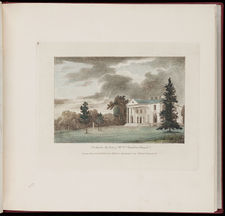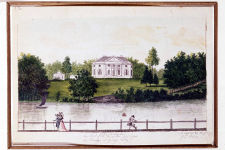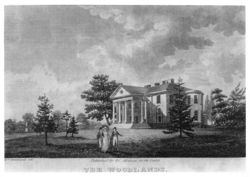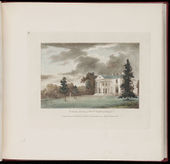The Woodlands
[Introductory sentence]
Overview
Alternate Names:
Site Dates:
Site Owner:
Site Designer(s):
Location:
[Google maps]
History
William Hamilton (whose estate, The Woodlands, overlooked Gray’s Garden from the opposite side of the river) urged his private secretary to search local plant dealers for specimens of Arabian Jasmine, African Heath, and double myrtles “as good as Gray’s.” In 1792 he complained of his secretary’s failure to “properly secure von Rohrs agave at Gray's,” as he “wish'd to prevent its getting into other hands.” For the same reason, Hamilton was eager to obtain the Grays’ specimens of Arbutus and Rose apple, “which however are priced so high that I do not imagine they will find a ready sale before my return.” [1] Statues often were placed on the lawn in front of the main façade of the house, as they were at The Woodlands, creating visual and physical ties between the ornamental style of the house and the garden scenery, as advised by British writer Thomas Whately (1770).
--Author
Texts
- Hamilton, William, 30 September 1785, in a letter to his secretary, Benjamin Hays Smith (quoted in Madsen 1988: A3) [2]
- “Step also the Diameter of the circle or ring that encloses the Ice House Hill & tell me the space from one to the other side of the walk & of the Ha.Ha.”
- G., L., June 15, 1788, describing The Woodlands, seat of William Hamilton, near Philadelphia, Pa. (Madsen 1988: B2) [3]
- “a little further on, you come to a charming spring, some part of the ground is hollowed out where Mr Hamilton is going to form a grotto, he has already collected some shells.”
- G., L., June 15, [1788?], describing The Woodlands, seat of William Hamilton near Philadelphia, Pa. (quoted in Madsen 1989: 19) [4]
- “[The walks were] planted on each side with the most beautiful & curious flowers & shrubs. They are in some parts enclosed with the Lombardy poplar except here & there openings are left to give you a view of some fine trees or beautiful prospect beyond, & in others, shaded by arbours of the wild grape, or clumps of large trees under which are placed seats where you may rest yourself & enjoy the cool air.”
- Hamilton, William, 1789, in a letter to his secretary, Benjamin Hays Smith, describing The Woodlands, seat of William Hamilton, near Philadelphia, Pa. (quoted in Madsen 1988: A4) [5]
- "In my Hurry at the time of coming off from Home I omitted to put in the ground the exotic Bulbous roots & as I gave no direction to Hilton respecting them they may suffer more especially as they were all taken out of the pots & left dry on the Back flue of the Hot House." [Fig. 5]
- Hamilton, William, September 1790, letter to his private secretary Benjamin Hays Smith(1905: 260)[6]
- "In case you go to Brannan's I beg you to look particularly at his largest Gardenias & Arbutus so as to give an account of the size as well as the prices of them. I mentioned to you the Teucrium or Germander & I now recollect his having what he called a china rose. I have moreover a shrewd suspicion that Gray's single Arabian Jasmine came from Brannans although Brannan may not know it by that name. You will therefore find out what Jasmines he has & their prices & see whether he has any aloes, Geraniums, myrtles &c which I have not. Possibly he may have another plant of the African Heath which Gray got from him & other large d'ble myrtles as good as Gray's. You will also make the same enquiries of Spurry….
- "Brannan had a trefoil which he called a cinquefoil. I know not whether it has yet travelled to Grays. I take it to be the moon-trefoil? a very pretty shrub."
- Hamilton, William, November 22, 1790, letter from The Woodlands to Humphry Marshall (Darlington 1849: 577)[7]
- "I was truly sorry that I did not see you when you were last at Philadelphia. I hope, the next time you come down, you will give me a call. If I can tempt you no other way, I promise to show you many plants that you have never yet seen, some of them curious."
- Hamilton, William, 1789 and 1790, in a letter to his secretary, Benjamin Hays Smith, describing The Woodlands, seat of William Hamilton, near Philadelphia, Pa. (quoted in Madsen 1988: A6, A7) [8]
- "[September 27, 1789] . . . The first moment after Hilton has finished weeding in the Garden as I directed he should set about weeding the terrace walk as I will endeavour to have it gravelld during the winter. . .
- "[October 12, 1789] . . . When the terrace is weeded, the two Borders leading from the House to the Ice House Hill should be cleaned. . .
- "[June 12, 1790] . . . The newly planted trees & shrubs along the terrace respecting which you know me to be so anxious, may be alive or dead for ought I know."
- La Rochefoucauld Liancourt, François-Alexandre-Frédéric, duc de, 1799, describing The Woodlands, seat of William Hamilton, near Philadelphia, Pa. (quoted in Madsen 1988: B3) [9]
- “You pass the Schuylkill at Gray’s-Ferry, the road to which runs below Woodlands, the seat of Mr. William Hamilton: it stands high, and is seen upon an eminence from the opposite side of the river.” [Fig. 9]
- Hamilton, William, November 23, 1796, letter from The Woodlands to Humphry Marshall (Darlington 1849: 578)[7]
- "I am much obliged to you for the seeds you were so good as to send me, of the Pavia, and of the Podophyllum or Jeffersonia.
- "When you were last here it was so late, and you were of course so much hurried, as to prevent your deriving any satisfaction in viewing my exotics. I hope when you come next to Philadelphia, that you will allot one whole day, at least, for the Woodlands. It will not only give me real pleasure to have your company, but I am persuaded it will afford some amusement to yourself.
- "Your nephew [Moses Marshall] did me the favour of calling, the other day; but he, too, was in a hurry, and had little opportunity of satisfying his curiosity. I flatter myself, however, that during his short stay he saw enough to induce him to repeat his visit. The sooner this happens, the more agreeable it will be to me.
- "When I was at your house, a year ago, I observed several matters in the gardening way, different from any in my possession. Being desirous to make my collection as general as possible, I beg to know if you have, by layers, or any other mode, sufficiently increased any of the following kinds so as to be able, with convenience, to spare a plant of each of them, viz.: — Ledum palustre, Carolina Rhamnus, Azalea coccinea, Mimosa Intsia, and Laurus Borbonia. Any of them would be agreeable to me; as also would be a plant, or seeds Hippophae Canadensis, Aralia hispida, Spiraea nova from the western country; Tussilago Petasites, Polymnia tetragonotheca, Hydrophyllum Canadense, H. Virginicum, Polygala Senega, P. biflora, Napoea scabra dioica, Talinum, a nondescript Sedum from the west, somewhat like the Telephium, two kinds of a genus supposed, by Dr. MARSHALL, to be between Uvularia and Convallaria [probably the Streptopus, of MICHAUX, which the MARSHALLS proposed to call Bartonia], and Rubia Tinctorum. I should also be obliged to you for a few seeds of your Calycanthus, Spigelia Marilandica, Tormentil from Italy, and two of your Oaks with ovate entire leaves."
- Hamilton, William, May 3, 1799, letter from The Woodlands to Humphry Marshall (Darlington 1849: 579-80)[7]
- "I have not until this time been able to comply with my promise of sending you a Tea Tree.
- "I now take the opportunity of forwarding you... a very healthy one, as well as several of other kinds, which I believe are not already in your collection; together with a small parcel of seeds....
- "Should anything else, in my possession, occur to you as a desirable addition to the variety in your garden, I beg you will inform me. You may be assured, whatever it is, if I have two of the kind, you will be welcome to one. Sensible as I am of your kindness and friendship to me, on all occasions, you have a right, and may freely command every service in my power.
- "Doctor Parke informs me you were lately in Philadelphia. Had it been convenient to you to call at the Woodlands, I should have had great pleasure in seeing you. I have not heard of Dr. MARSHALL'S having been in this neighbourhood since I was last Bradford. From the pressing invitation I gave him, I am willing to hope that, in case of his coming to town, he will not forget to give me a call. I beg you will present him with my best respects, and request of him to give me a line of information, as to the Menziesia ferruginea, particularly of its vulgar name, if it has one, where it grows, if he knows the name of any person in its neighbourhood, who is acquainted with it, so, as to direct or show it to any one who may go to look after it.
- "I intend, next month, to go to Lancaster; and if convenient to me, when there, to spare my George, I have thoughts of sending him to Redstone, for the Menziesia, and Podophyllum diphiyllum. If Dr. MARSHALL knows of any curious and uncommon plants, growing in the neighbourhood with those I have mentioned, I will be obliged to him to give me any intelligence by which he may suppose they can be found: or, if he knows any person or persons at Redstone, or Fort Pitt, who are curious in plants, of whom any questions on the subject may be asked, he cannot do me a greater service than by giving me their names and place of abode.
- "I do not know how your garden may have fared during this truly long and severe winter, which has occasioned the loss of several valuable ones in mine; amongst which are the Wise Briar [probably Schrankia uncinata, Willd.; Mimosa Intsia, Walt.] and Hibiscus speciosus, which I got from you. The plants, also, of Podophyllum diphyllum, which I raised last year, from seeds I received from your kindness, have, I fear, been all destroyed. They have not shown themselves above ground this spring. A tree, too (the only one I had of Juglans Pacane, or Illinois Hickory), which I raised twenty-five years ago from seed, is entirely killed.
- "In case you have seeds of the kinds named in the list hereto adjoined, I will thank you exceedingly for a few. Any of them which you have not, at present, I beg you will oblige me with them in the ensuing fall. I am very desirous to know if your Iva, or Hog's Fennel, from Carolina, produces seeds. In that case, I must entreat you for a few of them.
- "You will permit me, also, to remind you of your promise to spare me a plant or two of the White Persimmon, one of Azalea coccinea, and of the sour Calycanthus. If convenient to let me have a plant or two of your Stuartia Malachodendron, and of Magnolia acuminata, you will do me a great favour.
- "Anything left for me at the toll-gate, on the middle ferry wharf to the care of Mr. TRUEMAN, who constantly attends there, will reach me the same day that it arrives there....
- "I am very desirous to compare a flower of your Stuartia with J. Bartram's; and will be obliged to you for a good specimen.
- Cutler, Rev. Manasseh, January 2, 1802, describing The Woodlands, seat of William Hamilton, near Philadelphia, Pa. (1987: 2:145)[10]
- "We then walked over the pleasure grounds in front and a little back of the house. It is formed into walks, in every direction, with borders of flowering shrubs and trees. Between are lawns of green grass, frequently mowed to make them convenient for walking, and at different distances numerous copse of native trees, interspersed with artificial groves, which are set with trees collected from all parts of the world." [Fig. 3]
- Cutler, Rev. Manasseh, November 22, 1803, describing The Woodlands, seat of William Hamilton, near Philadelphia, Pa. (1888: 2:145) [11]
- "We then took a turn in the gardens and the green-houses. In the gardens, though ornamented with almost all the flowers and vegetables the earth affords, I was not able to walk long. The green-houses, which occupy a prodigious space of ground, I can not pretend to describe. Every part was crowded with trees and plants from the hot climates, and such as I had never seen, all the spices, the tea-plant in full perfection; in short, he assured us there was not a rare plant in Europe, Asia, or Africa, many from China and the islands in the South Seas, none, of which he had obtained any account, which he had not procured."

- Drayton, Charles, November 2, 1806, describing The Woodlands, seat of William Hamilton, near Philadelphia, Pa. (Drayton Hall, Charles Drayton Diaries, 1784–1820, typescript)
"[There is] a Spacious Conservatory [located] about 200 years [sic] to the west of the Mansion.
"The Conservatory consists of a green house, & 2 hot houses—one being at each end of it. The green house may be about 50 feet long. The front only is glazed. Scaffolds are erected one higher than another, on which the plants in pots or tubs are planted so that it represents a declivity of a mountain. at each end are Step-ladders, for the purposes of going on each Stage to water the plants—& to a walk at the back-wall. on the floor a walk of 5 or 6 feet extends along the glazed wall. & at each end a door opens into an Hot house— so that a long walk extends in one line along the Stove walls to the houses & the glazed wall of the green house.
"The Hot houses, they may extend in front I suppose 40 feet each. they have a wall heated by flues—& 3 glazed walls & a glazed roof each. in the centre, a frame of wood is raised about 2 1/2 feet high, & occupying the whole area except leaving a passage along by the walls. in the flue wall or adjoining, is a cistern for tropic aquatic plants. within the frame, is composed a hot bed; into which the pots & tubs with plants are plunged. This Conservatory is said to be equal to any in Europe. It contains between 7 & 8000 plants. To this the Professor of botany is permitted to resort, with his Pupils occasionally. As the position of many plants require external exposure in the Summer Season that also is contrived with much ingenuity & beauty. there are 2 large oval grass plats in front of the Conservatory—& 2 behind. holes are nicely made in these, to receive pots & tubs with their plants, even to their rims. the tallest are placed in the centre, & decreasing to the verge. thus they represent a miniature hill clothed with choice vegetation." [Fig. 9]
- Drayton, Charles, 2 November 1806, describing The Woodlands, seat of William Hamilton, near Philadelphia, Pa. (Drayton Hall, Charles Drayton Diaries, 1784–1820, typescript)
- “The Garden consists of a large verdant lawn surrounded by a belt or walk, & shrubbery for some distance. the outer side of the walk is adorned here & there, by scattered forest trees, thick & thin. It is bounded, partly as is described—partly by the Schylkill [sic] & a creek exhibiting a Mill & where it is scarcely noticed, by a common post and rail. The walk is said to be a mile long—perhaps it is something less. one is led in to the garden from the portico, to the east and left hand. or from the park, by a small gate contiguous to the house. traversing this walk, one sees many beauties of landscape.”
- Drayton, Charles, November 2, 1806, describing The Woodlands, seat of William Hamilton, near Philadelphia, Pa. (Drayton Hall, Charles Drayton Diaries, 1784–1820, typescript), back up to history
- "The Garden consists of a large verdant lawn surrounded by a belt or walk, & shrubbery for some distance. the outer side of the walk is adorned here & there, by scattered forest trees, thick & thin. It is bounded, partly as is described—partly by the Schylkill [sic] & a creek exhibiting a Mill & where it is scarcely noticed, by a common post and rail. The walk is said to be a mile long—perhaps it is something less. one is led in to the garden from the portico, to the east and lefthand. or from the park, by a small gate contiguous to the house. traversing this walk, one sees many beauties of landscape—also a fine statue, symbol of Winter, & age." [Fig. 10]
- Drayton, Charles, November 2, 1806, describing The Woodlands, seat of William Hamilton, near Philadelphia, Pa. (Drayton Hall, Charles Drayton Diaries, 1784–1820, typescript)
- "The Fences separating the Park-lawn from the garden on one hand, & the office yard on the other, are 4 ft 6 high. The former are made with posts & lathes—the latter with posts, rails & boards. They are concealed with evergreens hedge—of juniper I think. . . .
- "The Stables & sheds, form the 3rd side of this three sided yard—The stables are seen from the front door of the house, over the hedge that screens the Yard."
- Drayton, Charles, 2 November 1806, describing The Woodlands (Drayton Hall, Charles Drayton Diaries, 1784–1820, typescript)
- “The Approach, its road, woods, lawn & clumps, are laid out with much taste & ingenuity. Also the location of the Stables: with a Yard between the house, stables, lawns of approach or park, & the pleasure ground or garden. The Fences seperating [sic] the Park-lawn from the Garden on one hand, & the office yard on the other, are 4 ft. 6 high. The park lawn is not in good order for lack of being fed upon. . . . Its fences where it is not visible from the house, is of common posts & rails. . . .
- “The former are made with posts & lathes—the latter with posts, rails & boards. They are concealed with evergreens hedge—of juniper I think.”

- Martin, William Dickinson, May 20, 1809, describing The Woodlands, seat of William Hamilton, near Philadelphia, Pa. (CWF)
- “Altho’ much has been done to beautify this delightful seat, much still remains to be done, for the perfecting it in all the capabilities which nature in her boundless profusion has bestowed.”
Images
William Russell Birch, "Woodlands, the Seat of Mr. Wm. Hamilton, Pennsylva.," 1808, in William Russell Birch and Emily Cooperman, The Country Seats of the United States (2009), p. 69, pl. 14.
Other Resources
Notes
- ↑ William Hamilton and Benjamin H. Smith, "Some Letters from William Hamilton, of the Woodlands, to His Private Secretary (Concluded)," The Pennsylvania Magazine of History and Biography, 29 (1905): 257–67 260, 264, view on Zotero.
- ↑ Madsen, Karen. 1988. “William Hamilton’s Woodlands.” Paper presented for seminar in American Landscape, 1790–1900, instructed by E. McPeck. Radcliffe Institute for Advanced Study, Harvard University. view on Zotero
- ↑ Karen Madsen, "William Hamilton’s Woodlands" (Paper presented for seminar in American Landscape, 1790-1900, instructed by E. McPeck. Radcliffe Institute for Advanced Study, Harvard University, 1988), view on Zotero.
- ↑ Karen Madsen, "To Make His Country Smile: William Hamilton’s Woodlands," Arnoldia, 49 (1989), 14–23, view on Zotero.
- ↑ Karen Madsen, ‘William Hamilton’s Woodlands’, 1988, view on Zotero.
- ↑ Hamilton and Smith, 1905, 260.
- ↑ 7.0 7.1 7.2 Cite error: Invalid
<ref>tag; no text was provided for refs namedDarlington - ↑ Karen Madsen, “William Hamilton’s Woodlands.” Paper presented for seminar in American Landscape, 1790–1900, instructed by E. McPeck. Radcliffe Institute for Advanced Study, Harvard University. 1988.view on Zotero.
- ↑ Karen Madsen, "William Hamilton’s Woodlands," (Paper presented for seminar in American Landscape, 1790-1900, instructed by E. McPeck. Radcliffe Institute for Advanced Study, Harvard University, 1988), view on Zotero.
- ↑ William Parker Cutler, Life, Journals, and Correspondence of Rev. Manasseh Cutler, LL. D (Athens, Ohio: Ohio University Press, 1987), view on Zotero
- ↑ Masnasseh Cutler, Life, Journals and Correspondence of Rev. Manasseh Cutler, L.L.D., ed. by William Parker Cutler and Julia Perkin Cutler, 2 vols. (Cincinnati: Robert Clarke & Co, 1888), view on Zotero




